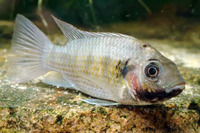|
Sarotherodon melanotheron melanotheron, Blackchin tilapia: fisheries, aquaculture, aquarium

| 해상도: 500x333
파일크기: 43745 Bytes
등록시간: 2008:04:15 18:27:08
|
Sarotherodon melanotheron melanotheron, Blackchin tilapia: fisheries, aquaculture, aquarium
Image of Sarotherodon melanotheron melanotheron, Blackchin tilapia, Lue, Vestafrikansk mundruger, Blackchin mouthbrooder, Silvery tilapia, Akpanoe, Ditsame, Mustaleukatilapia, Schwarzkinnmaulbrüter, Gargaza, Ifunu, Mpupa, Tome, Ukuobu, Karwa, Tsokungi, Tilapia wielkoglowa, Epia
Teigler, F.
Point map
Order:
Perciformes
(perch-likes)
Class:
Actinopterygii (ray-finned fishes)
FishBase name:
Blackchin tilapia
|
^o^
동물그림창고 똑똑전화 누리집
^o^
|
|